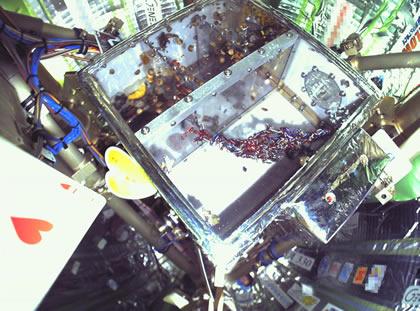Nearly a month after the successful launch and deployment of an inflatable model space hotel (see 'The inflatable space hotel '), the craft is still going strong — but the fate of its residents is as yet unknown.
The spacecraft, a 4-metre-wide watermelon-shaped hostelry called Genesis I, was launched on 12 July by US hotelier and millionaire Robert Bigelow. His company, Las Vegas-based Bigelow Aerospace, aims to use the test-run to develop inflatable space habitats for humans.
 The Mexican jumping beans (in the top section of the box, amidst various toys and household objects donated by the team) seem to have sprouted.credit Bigelow Aerospace
The Mexican jumping beans (in the top section of the box, amidst various toys and household objects donated by the team) seem to have sprouted.credit Bigelow AerospaceBut for the meantime, this craft carries four Madagascar hissing cockroaches and roughly 20 Mexican jumping beans. News@nature.com set out to discover what had become of these hapless guests, and take a look at the state of their hotel room.
After launch, Genesis I was inflated with compressed air. That all went well and the leak rate — a concern for any spacecraft, inflatable or not — is so low that it is barely detectable. The temperature on board is a comfy 26 ºC. The only technical hitch so far is that the ship has adopted a slow roll that makes it difficult for land-based monitoring stations to get a fix on its antennas. That has slowed data downloading and delayed transmission of live video feed.
Without video, mission controllers are struggling to use still pictures to ascertain the situation on board.
Growing up
"It actually looks like some of the jumping beans have hatched and grown," says programme manager Eric Haakonstad. The roaches are in different places in different pictures, he adds, but he can't tell whether they are roaming around on their own or merely being jostled by movements of the ship.
The cockroaches were last seen alive on 16 June, when they were loaded in mesh-covered boxes into the craft. They were left in captivity, dining on water and dried dog kibble, until the delayed launch on 12 July subjected them to vibrations and acceleration. They were then in a vacuum for a few minutes before the Genesis I craft was deployed and inflated.
That would be enough to kill many creatures, but not necessarily the hardy cockroach, which can survive many weeks without food. Charles Cockell, now a professor at the Planetary and Space Sciences Research Institute of Open University, UK, once studied how well cockroaches can withstand a drop in atmospheric pressure. At 100 millibars — one-tenth of normal atmospheric pressure - the bugs actively pumped air into their abdomens to survive, he found, swelling themselves up in the process to about one and a half times the normal size. "It's pretty gross actually," says Cockell.
Bigelow Aerospace tested a number of different cockroaches and found that the Madagascar hissing roach, which can grow to more than 7.5 centimetres long and can weigh as much as 24 grams, proved that they had the right stuff by enduring more than 2 hours in a vacuum. "After 20 to 30 minutes they came back to life and we thought 'Oh my gosh, they deserve to go to space'," says Bigelow.
Five stars
Conditions aboard Genesis II, tentatively scheduled for launch at the end of 2007, will be comparatively posh. "All the other critters on Genesis II will have self-contained oxygen and nitrogen systems so the vacuum won't affect them," says Bigelow. That mission is planned to carry two ant farms and a few scorpions into space.
Haakonstad says Genesis I should last at least 5 years before losing orbit and burning up in the Earth's atmosphere, making "a spectacular little comet."
ADVERTISEMENT
If the crew is still alive today, they may yet face a few more crises before dying of starvation in about 6 months time. The team at Bigelow Aerospace cut a few safety corners on Genesis I, says William Schneider, a professor at Texas A&M University in College Station, and consultant to Bigelow Aerospace. There is only one layer of material holding air in the interior; a space vessel for human inhabitants would have at least three in case one is pierced. "We don't have to make it that redundant for roaches," says Schneider.
If and when high-resolution video starts streaming down from the craft the team will find out whether it needs to worry about the health of their guests. Keep an eye on their website for updates.
Visit our hotelgetsacheckup.html">newsblog to read and post comments about this story.
